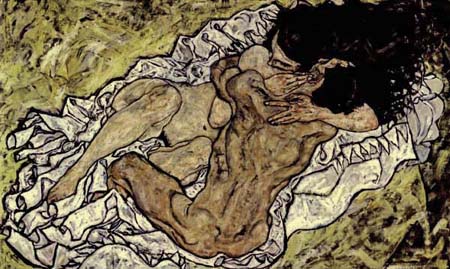 Egon Schiele was an Austrian artist and protege of Gustav Klimt. Controversial due to his paintings of young girls--and alleged relations with them--he was jailed for seducing a girl under the age of consent in 1912. The charge was eventually dropped, but he was found guilty of exhibiting erotic art in a place where children could see it. He was known for his twisted, expressionist figures. Schiele died in 1918 at the age of twenty-eight in the influenza epidemic.
Egon Schiele was an Austrian artist and protege of Gustav Klimt. Controversial due to his paintings of young girls--and alleged relations with them--he was jailed for seducing a girl under the age of consent in 1912. The charge was eventually dropped, but he was found guilty of exhibiting erotic art in a place where children could see it. He was known for his twisted, expressionist figures. Schiele died in 1918 at the age of twenty-eight in the influenza epidemic.His paintings are sexual in an at-times-discomfiting manner. The bodies are distorted, the gaze sometimes voyeuristic. In the brochure for their 1997 exhibition of his work the MoMA wrote:
The very aspects of Schiele's art that precluded its popularity during much of his lifetime--ugly distortion in place of accepted notions of beauty, unveiled eroticism, and personal angst--are those for which it is considered most compelling today.
 His work is simultaneously a product of its time and modern feeling. Although he enrolled in the Vienna Academy of the Fine Arts, he eventually dropped out, disillusioned by their traditionalism. He was mentored then by Klimt, who was an established artist in Vienna at the time, although his art is of a different school than Klimt's. ArtAndCulture.com writes:
His work is simultaneously a product of its time and modern feeling. Although he enrolled in the Vienna Academy of the Fine Arts, he eventually dropped out, disillusioned by their traditionalism. He was mentored then by Klimt, who was an established artist in Vienna at the time, although his art is of a different school than Klimt's. ArtAndCulture.com writes:

Klimt and Schiele's friendship created a bridge between nineteenth-century Symbolism and twentieth-century Expressionism. Symbolism, in its search for a subject matter based in the emotions, dreams, and the subconscious, had discovered a new set of icons. Chief among them was the femme fatale, an archetype of eroticism and mysticism. She appears frequently in the work of Klimt and Edvard Munch, where her figure is a combination of erotic allure and morbid repulsion. Schiele and other Expressionists picked up on this theme but made it more personal, exploring the psychological conflicts inherent in desire, and using more violent pictorial means to convey the body’s painful wrenching at the hands of both Eros and Thanatos.
 Not then, an easy sort of art but the type that is challenging and exposing. A tangled set of emotions exposed through painting and drawing.
Not then, an easy sort of art but the type that is challenging and exposing. A tangled set of emotions exposed through painting and drawing.I'd never heard of him before today, but I went to a play about him this evening with a couple of my uncles and aunts plus a cousin that was part of The American Living Room 2007 at Here. They're showing super brief runs of plays (2 days) and this one was put on by the Human Company. The air conditioner in the theater was broken and it was very hot and hard to breathe. I can't imagine what it must have been like for the poor actors who were under the lights. Despite the discomfort though, it was a very interesting play.
Schiele interweaves dance and music. This is most effective at times when the actors go through a series of repetitive motions, grasping the edges of their chairs as if in fear, reaching forward with both arms and to the side with one as though imploring someone who is present only in spirit, and so on and so forth.
 The play focuses largely on his relationships with three women: his mistress, his sister, and the girl who caused him to go to jail. I series of vignettes, the goal is certainly not realism. There is a master of ceremonies, but at points the actors also break the fourth wall, handing out chocolates to the audience and addressing them directly when speaking of things they are guilty of. While not traditional in its approach, it avoids the use of technology--which I think more often than not has a distancing effect, although it sometimes works--and succeeds in creating a consistently interesting play that discusses big concepts while also remaining completely human and grounded.
The play focuses largely on his relationships with three women: his mistress, his sister, and the girl who caused him to go to jail. I series of vignettes, the goal is certainly not realism. There is a master of ceremonies, but at points the actors also break the fourth wall, handing out chocolates to the audience and addressing them directly when speaking of things they are guilty of. While not traditional in its approach, it avoids the use of technology--which I think more often than not has a distancing effect, although it sometimes works--and succeeds in creating a consistently interesting play that discusses big concepts while also remaining completely human and grounded.
No comments:
Post a Comment